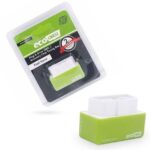Are you looking to understand your Mercedes-Benz’s engine performance better? Obd2 Rpm, or Revolutions Per Minute, provides crucial insights into your engine’s operation. At MERCEDES-DIAGNOSTIC-TOOL.EDU.VN, we help you decode this data, offering tools and expertise to optimize your vehicle’s health. Learn how to access and interpret this valuable information to maintain your Mercedes-Benz in top condition.
Contents
1. Understanding OBD2 and RPM
1.1 What is OBD2?
OBD2, or On-Board Diagnostics II, is a standardized system used in most vehicles today. According to the EPA, OBD2 was standardized in 1996 to monitor emissions and engine performance, and it offers a wealth of diagnostic information. It allows you to access various engine parameters using a diagnostic tool. This system provides access to a variety of data related to your vehicle’s performance.
1.2 What is RPM?
RPM stands for Revolutions Per Minute, and it measures how many times the engine’s crankshaft completes a full rotation in one minute. RPM is a key indicator of engine speed and load. High RPMs can indicate aggressive driving, while low RPMs can signify efficient fuel consumption. It’s a fundamental metric for understanding engine behavior.
1.3 Why is OBD2 RPM Important?
Understanding OBD2 RPM helps you monitor engine health, optimize fuel efficiency, and diagnose potential issues early. Monitoring RPM can help you identify issues like irregular idling, misfires, or transmission problems. This knowledge allows for proactive maintenance, preventing costly repairs down the line.
2. How to Read OBD2 RPM on Your Mercedes-Benz
2.1 Tools Needed
To read OBD2 RPM, you’ll need:
- OBD2 Scanner: This device plugs into your car’s OBD2 port.
- Smartphone or Laptop: Many scanners connect to these devices via Bluetooth or USB.
- Diagnostic App or Software: This interprets the data from the scanner.
MERCEDES-DIAGNOSTIC-TOOL.EDU.VN offers a range of diagnostic tools compatible with Mercedes-Benz vehicles.
2.2 Locating the OBD2 Port
The OBD2 port is usually located under the dashboard on the driver’s side. According to the National Highway Traffic Safety Administration (NHTSA), standardized placement makes it easier for technicians and vehicle owners to access diagnostic information. Refer to your Mercedes-Benz owner’s manual for the exact location if needed.
2.3 Connecting the OBD2 Scanner
- Turn off the ignition: Ensure the car is not running before plugging in the scanner.
- Plug in the scanner: Connect the scanner to the OBD2 port.
- Turn on the ignition: Turn the key to the “on” position without starting the engine.
- Pair the device: If using a Bluetooth scanner, pair it with your smartphone or laptop.
2.4 Using Diagnostic Software
- Launch the app: Open the diagnostic app or software on your device.
- Connect to the scanner: Follow the app’s instructions to connect to the OBD2 scanner.
- Select Real-Time Data: Choose the option to view real-time data or live data.
- Find RPM: Look for “RPM” in the list of available parameters.

